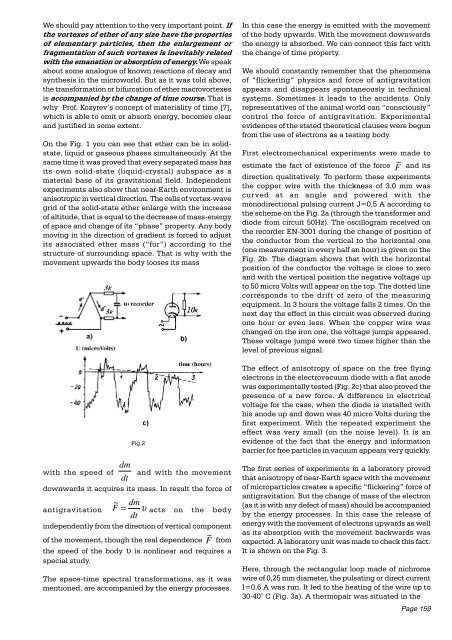Reactionless Propulsion and Active Force - Practical Guide to Free ...
Reactionless Propulsion and Active Force - Practical Guide to Free ...
Reactionless Propulsion and Active Force - Practical Guide to Free ...
You also want an ePaper? Increase the reach of your titles
YUMPU automatically turns print PDFs into web optimized ePapers that Google loves.
We should pay attention <strong>to</strong> the very important point. If<br />
the vortexes of ether of any size have the properties<br />
of elementary particles, then the enlargement or<br />
fragmentation of such vortexes is inevitably related<br />
with the emanation or absorption of energy. We speak<br />
about some analogue of known reactions of decay <strong>and</strong><br />
synthesis in the microworld. But as it was <strong>to</strong>ld above,<br />
the transformation or bifurcation of ether macrovortexes<br />
is accompanied by the change of time course. That is<br />
why Prof. Kozyrev’s concept of materiality of time [7],<br />
which is able <strong>to</strong> emit or absorb energy, becomes clear<br />
<strong>and</strong> justified in some extent.<br />
On the Fig. 1 you can see that ether can be in solidstate,<br />
liquid or gaseous phases simultaneously. At the<br />
same time it was proved that every separated mass has<br />
its own solid-state (liquid-crystal) subspace as a<br />
material base of its gravitational field. Independent<br />
experiments also show that near-Earth environment is<br />
anisotropic in vertical direction. The cells of vortex-wave<br />
grid of the solid-state ether enlarge with the increase<br />
of altitude, that is equal <strong>to</strong> the decrease of mass-energy<br />
of space <strong>and</strong> change of its “phase” property. Any body<br />
moving in the direction of gradient is forced <strong>to</strong> adjust<br />
its associated ether mass (“fur”) according <strong>to</strong> the<br />
structure of surrounding space. That is why with the<br />
movement upwards the body looses its mass<br />
Fig.2<br />
dm<br />
with the speed of <strong>and</strong> with the movement<br />
dt<br />
downwards it acquires its mass. In result the force of<br />
antigravitation<br />
~<br />
F =<br />
dm<br />
υ<br />
dt<br />
acts on the body<br />
independently from the direction of vertical component<br />
of the movement, though the real dependence F ~ from<br />
the speed of the body υ is nonlinear <strong>and</strong> requires a<br />
special study.<br />
The space-time spectral transformations, as it was<br />
mentioned, are accompanied by the energy processes.<br />
In this case the energy is emitted with the movement<br />
of the body upwards. With the movement downwards<br />
the energy is absorbed. We can connect this fact with<br />
the change of time property.<br />
We should constantly remember that the phenomena<br />
of “flickering” physics <strong>and</strong> force of antigravitation<br />
appears <strong>and</strong> disappears spontaneously in technical<br />
systems. Sometimes it leads <strong>to</strong> the accidents. Only<br />
representatives of the animal world can “consciously”<br />
control the force of antigravitation. Experimental<br />
evidences of the stated theoretical clauses were begun<br />
from the use of electrons as a testing body.<br />
First electromechanical experiments were made <strong>to</strong><br />
estimate the fact of existence of the force ~<br />
F <strong>and</strong> its<br />
direction qualitatively. To perform these experiments<br />
the copper wire with the thickness of 3,0 mm was<br />
curved at an angle <strong>and</strong> powered with the<br />
monodirectional pulsing current J=0,5 A according <strong>to</strong><br />
the scheme on the Fig. 2a (through the transformer <strong>and</strong><br />
diode from circuit 50Hz). The oscillogram received on<br />
the recorder EN-3001 during the change of position of<br />
the conduc<strong>to</strong>r from the vertical <strong>to</strong> the horizontal one<br />
(one measurement in every half an hour) is given on the<br />
Fig. 2b. The diagram shows that with the horizontal<br />
position of the conduc<strong>to</strong>r the voltage is close <strong>to</strong> zero<br />
<strong>and</strong> with the vertical position the negative voltage up<br />
<strong>to</strong> 50 micro Volts will appear on the <strong>to</strong>p. The dotted line<br />
corresponds <strong>to</strong> the drift of zero of the measuring<br />
equipment. In 3 hours the voltage falls 2 times. On the<br />
next day the effect in this circuit was observed during<br />
one hour or even less. When the copper wire was<br />
changed on the iron one, the voltage jumps appeared.<br />
These voltage jumps were two times higher than the<br />
level of previous signal.<br />
The effect of anisotropy of space on the free flying<br />
electrons in the electrovacuum diode with a flat anode<br />
was experimentally tested (Fig. 2c) that also proved the<br />
presence of a new force. A difference in electrical<br />
voltage for the case, when the diode is installed with<br />
his anode up <strong>and</strong> down was 40 micro Volts during the<br />
first experiment. With the repeated experiment the<br />
effect was very small (on the noise level). It is an<br />
evidence of the fact that the energy <strong>and</strong> information<br />
barrier for free particles in vacuum appears very quickly.<br />
The first series of experiments in a labora<strong>to</strong>ry proved<br />
that anisotropy of near-Earth space with the movement<br />
of microparticles creates a specific “flickering” force of<br />
antigravitation. But the change of mass of the electron<br />
(as it is with any defect of mass) should be accompanied<br />
by the energy processes. In this case the release of<br />
energy with the movement of electrons upwards as well<br />
as its absorption with the movement backwards was<br />
expected. A labora<strong>to</strong>ry unit was made <strong>to</strong> check this fact.<br />
It is shown on the Fig. 3.<br />
Here, through the rectangular loop made of nichrome<br />
wire of 0,25 mm diameter, the pulsating or direct current<br />
I=0,6 A was run. It led <strong>to</strong> the heating of the wire up <strong>to</strong><br />
30-40° C (Fig. 3a). A thermopair was situated in the<br />
Page 159

















